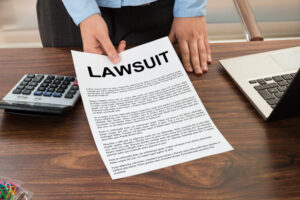
There are legal requirements you must meet to sue someone in Florida. Lawyers call these requirements “standing.” The three elements of standing to sue in Florida are “injury in fact,” “causation,” and “redressability.” But what do these terms mean when you strip away the convoluted legalese?
At Zervos & Calta, PLLC, our Tampa injury attorneys believe you can understand your personal injury claim better when you know key legal terms and concepts. If you don’t understand the legal elements of standing, you’re not alone. Here’s everything you need to know in clear, accessible terms.
Contents
What Is Standing to Sue?
In the legal field, “standing” refers to whether someone has the right to bring a case to court. So, in personal injury cases, to have standing, the person filing a lawsuit must show that they sustained an injury due to another party’s actions or failure to act. If the person filing suit doesn’t have standing, the court will not hear the case.
What Is Injury in Fact?
“Injury in fact” is the first crucial element of standing in Florida personal injury law cases. Essentially, the term means that a person must show they were actually harmed in some way to bring a lawsuit. For personal injury claims, this harm is usually physical and often leads to emotional and financial damage. For example, if someone sustained injuries in a car crash, their injuries would count as an “injury in fact.”
To satisfy this requirement, it’s not enough to say something could have happened. The person filing the lawsuit must show that the harm occurred. This requirement helps make sure that only people who have been directly affected by an injury can file a lawsuit.
What Is Causation?
“Causation” is the second element of standing someone must prove to file a personal injury lawsuit in Florida. To satisfy this element of standing, the person filing a lawsuit must demonstrate a clear connection between the harm they experienced and the actions of another person or party.
In plain terms, causation asks, “Did this person’s or organization’s actions cause the injury?” For example, if a driver runs a red light and crashes into another car, the driver who ran the red light caused the other driver’s injuries. Without proving causation, there’s no link between what the alleged at-fault party did and the harm that happened.
What Is Redressability?
The final element of standing to sue someone in Florida is “redressability.” Redressability means the court can fix the harm to the person who filed the lawsuit. In other words, the court must be able to offer a solution or compensation that will make things right or at least help with the injury.
For example, if someone sustains injuries in an accident, redressability means the court can award money to cover the injured person’s medical bills, lost wages, or other losses. If the court cannot provide any real help or solution, then the person doesn’t have standing to sue. Redressability ensures that a lawsuit will help the injured person, such as by awarding them financial compensation, rather than leading to an empty court ruling.
What Are Some Examples of Standing to Sue in Florida Personal Injury Cases?
Anyone who suffers an injury due to someone else’s negligent or intentional actions likely has standing to file a personal injury lawsuit in Florida. Some common examples of when people have legal standing to sue are:
Car Accident
If a person suffers severe injuries in a collision resulting from another driver’s negligence, like speeding or texting while driving, they would have standing to sue the at-fault driver. The injury in fact may be a traumatic brain injury from the accident, and the victim can show causation by proving the other driver’s actions led to the crash. The court can also help the crash victim by ordering the negligent driver to pay the victim compensation, satisfying the redressability element of standing.

Slip-and-Fall
If someone slips and falls in a grocery store because of a wet floor that wasn’t cleaned up or marked with a warning sign, they may have standing to sue the store owner. The injury in fact could be a broken wrist from the fall, and they would need to show that the store’s failure to keep the area safe caused the accident. If the person who fell can prove negligence, the court can order the store owner to pay them damages, which would meet the redressability requirement to file a lawsuit.
Defective Product
If a person suffers an injury from a defective product, such as an appliance that malfunctions and causes burns, they would have standing to sue the manufacturer. The injury in fact is the burn, and they would need to prove that the defect in the product was the direct cause of the harm. As with the examples above, a court could order the manufacturer to compensate the victim for their injuries and other losses, meeting the redressability requirement.
How Can a Lawyer Help Me?
At Zervos & Calta, PLLC, we understand how overwhelming it can be to navigate the legal system yourself. Our Tampa personal injury lawyers can help you determine whether you have standing to sue by evaluating the facts of your case and ensuring you meet all the legal requirements.
We’ll gather evidence to show the harm you’ve sustained, prove who caused your injuries, and demonstrate that the court can help make things right. Our team will handle all the legal work in your personal injury case, from filing paperwork to negotiating with insurance companies and representing you at trial if necessary.
While we protect your rights, you can focus on healing without the stress of managing a complex legal battle.
Contact a Florida Personal Injury Lawyer
You typically only have two years after an accident to file a lawsuit. Contacting a lawyer right away ensures you don’t miss your chance to pursue compensation. Call the personal injury law firm of Zervos & Calta, PLLC today or complete our contact form for a free consultation.


